I thought you'd enjoy seeing a "sneak peek" of the Hanze HiFi HAT turntable power supply review for Positive Feedback that I'm putting the finishing touches on now.
Enjoy!
Welcome to Hanze HiFi!
I always enjoy telling you about the people behind high-performance audio products and hifi shops, as quite often they are the most insightful and informed of all enthusiasts about hifi, telling us about new and exciting audio advancements, and possessing a zeal and vision that drives audio performance to that next level, enriching our hifi hobby, our music listening, and our lives in the process.

Hanze HiFi in Zwolle, Netherlands.
Such are the people that are Hanze HiFi, located in the historic and picturesque city of Zwolle, Netherlands. Hanze HiFi is the sort of hifi business that every audio enthusiast wished was just around the corner from their home.

Hanze HiFi selfie with Jaap (technician, left), Johan (owner, center), and Alexander (sales, right).
Hanze HiFi is an enthusiast hifi company that hosts a large range of quality hifi brands, and whose goal is to give their customers the most enjoyable home hifi listening experience possible.
“We listen to you and your audio wishes, and together we will optimize your living room into the best setting for listening to your music, with the right components for you, for a sensational personalized listening experience.”
Towards achieving that end, Hanze Hifi assists its customers in learning about and listening to the products that will provide them the type of performance they desire, at a price that fits within their hifi budget, and then assists them in getting their new hifi installed at home to achieve the best performance possible in their home listening space, with the intent of providing listening pleasure for many years to come.
That’s an excellent recipe for happy and satisfied customers that most of us consumers in the enthusiast hifi world can only dream about experiencing.
Many hifi enthusiasts face the difficult challenge of sifting through all of the marketing of a multitude of hifi brands, reading the reviews about those that they might be interested in, as they pursue a quest to find something they will truly enjoy listening to at home for the long term.
The reality is that there is so much information available these days that it can be a daunting challenge for a hifi enthusiast to truly find the hifi equipment that will make them happy in their home music listening over the long term.
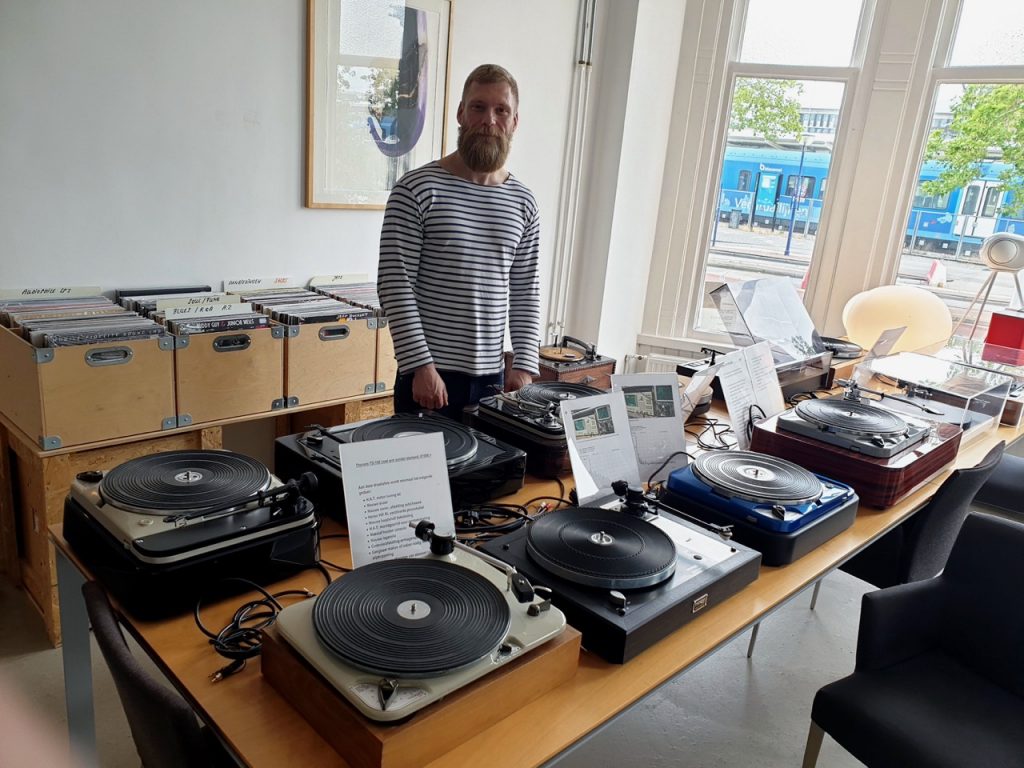
Alexander in the Hanze HiFi turntable room.
Or as Hanze HiFi told me, “it makes it difficult to see the forest for the trees” in audio, so they assist their customers in narrowing down their choices to help them find those audio gems that will match their performance expectations and give them the best home listening experience possible, and in doing so provide them many years of satisfaction.
Hanze HiFi emphasizes the "art of listening" to assist their customers in experiencing and comparing various hifi equipment so they can form their own opinions about performance, and how important those performance differences are to them, and whether those differences are worth the cost to them.
Hanze HiFi considers this selection and learning process to be the key aspect of providing customers a happy home listening experience and long-term satisfaction from their hifi system.
To support the selection process Hanze HiFi provides opportunities for listening sessions in listening rooms which are acoustically equivalent to their home situation.
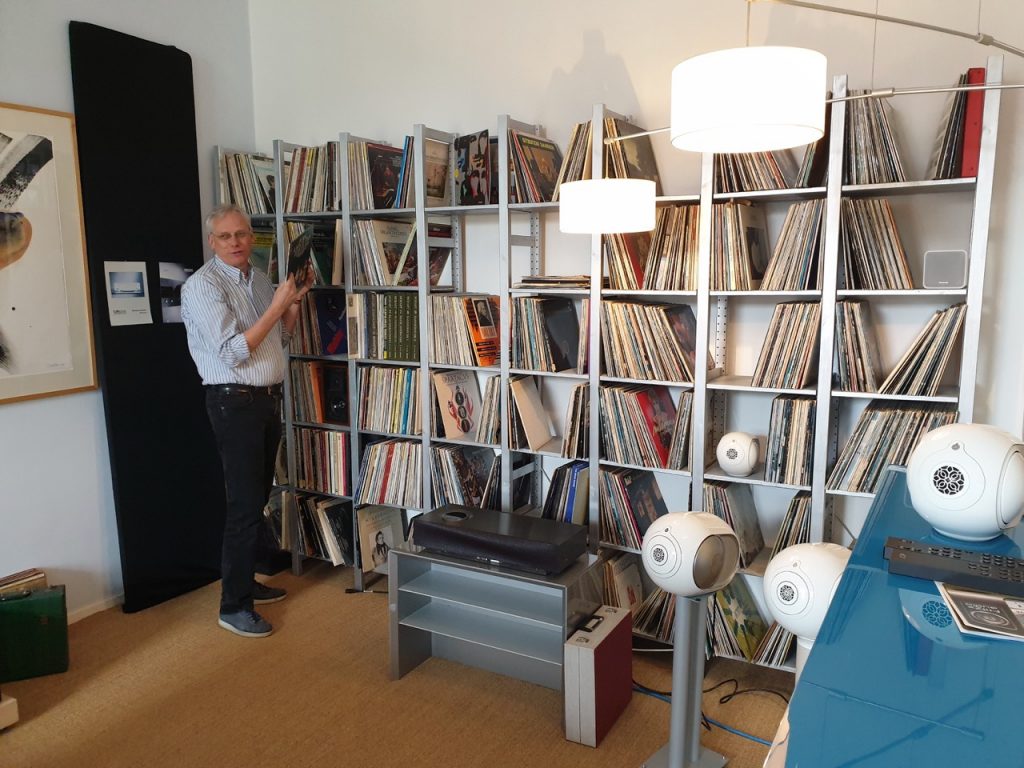
Owner Johan in Hanze HiFi's analog listening room.
Hanze HiFi installs hifi systems into their listening rooms, with speakers and equipment that match the customers tastes, budgets, and desires, and a Hanze HiFi consultant assists the customer in gaining experience operating the various products during the listening sessions, so they can better understand what the products do and are capable of, and what attributes they value most.
Hanze HiFi believes that spending longer times in the listening rooms so that customers can truly understand their personal tastes and preferences in audio, shifts the customer from a quantitative gear-swapping listening experience that can be confusing, to a qualitative listening experience that truly helps them to discover whether the system being listened to is really what will make them happy for the long term with respect to price, operation, and the quality of the sound reproduction.
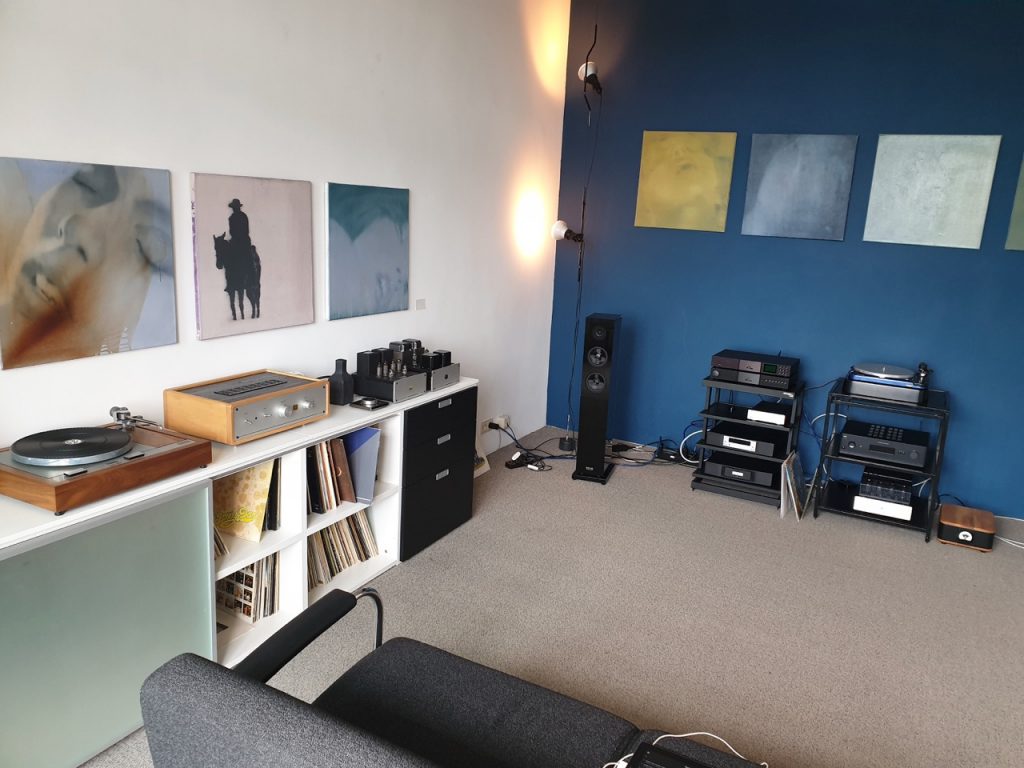
In addition to the consultants that can answer questions and help guide customers in discovering what truly makes them happy in audio, Hanze HiFi also has its own highly experienced technical service organization that can provide technical support to the customer over the long-term to ensure long-term audio happiness.
In the photo below you can see Jaap working on the most complex turntable from Thorens, the TD224 record changer.
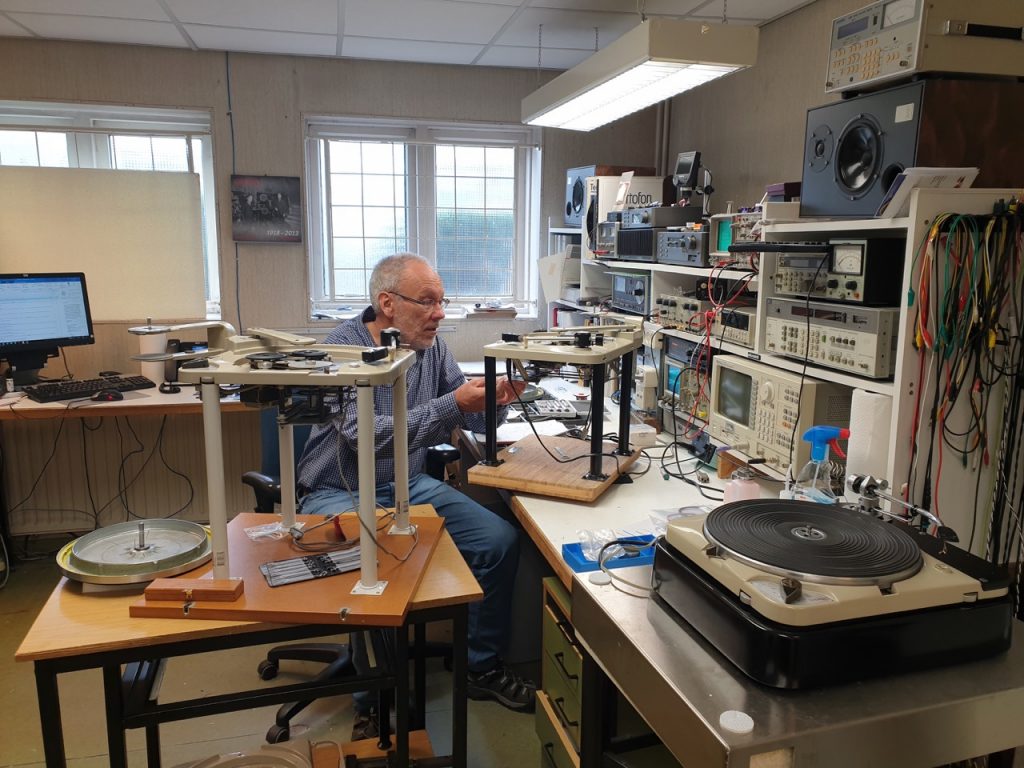
Jaap working on the Thorens TD224 record changer.
Many of us attempt to go through this discovery process on our own, resulting in a lot of poor choices and a lot of wasted money, as we try to better understand what sort of hifi system will make us happy for the long-term.
Hanze HiFi’s staff assisting in this discovery process saves the customer time, money, and frustration, enabling them to focus in on finding the right hifi system for theirs tastes and budget, and the presence and support of a talented service organization helps customers keep their hifi’s in tip-top shape over long term, ensuring long-term customer satisfaction.
Jaap Pees of Hanze HiFi
As one example of the long-term commitment Hanze HiFi makes to its customers, let me tell you about one of Hanze HiFi’s technical experts, Jaap Pees (below).

If you are Thorens TD-124 turntable enthusiast like I am, you’ve probably already heard about Jaap’s expertise related to classic studio & home turntables like the Thorens’, Garrard’s, and others.
Jaap has been working as a hi-fi audio technician for over 45 years now, with the last 20 years at Hanze HiFi. For the last 10 years Jaap has mainly focused his research on classic record players, how to best maintain them, and how to get the best performance out of these classic turntable designs, which continue to delight their owners with their high-performance music reproduction decades after their acquisition.
Like all thing’s audio, eventually these classic turntables will require some maintenance or restoration to perform at their optimum level of performance.
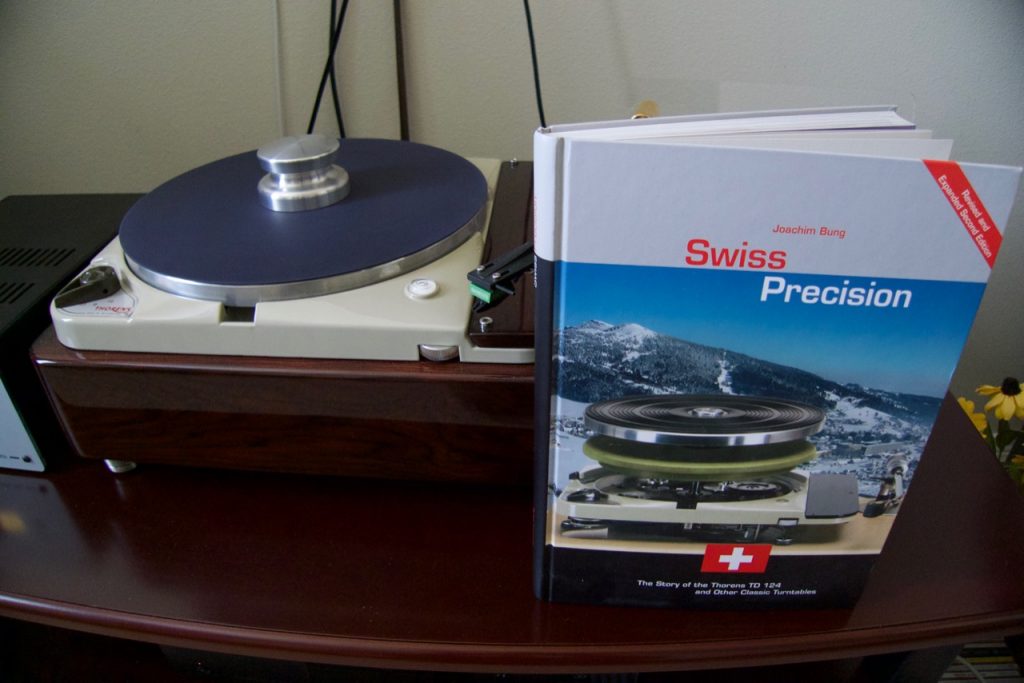
Jaap tells me his interest in record players was aroused when he went to overhaul a Thorens TD-124 for a customer and discovered that its special drive train was not so easy to restore due to its belt and intermediate wheel transmission, which many Thorens enthusiasts have difficulty with eventually.
If you are like me, you want to make sure your classic Thorens TD-124 turntable is running in tip-top shape, and Jaap can assist you with that, just like he has assisted me.
I bought a beautiful Artisan Fidelity Thorens TD-124 Statement turntable, with everything restored to perfection, and with many high-quality performance upgrades installed into it to get the best possible performance out of it.
Well, being the geeky classic hifi enthusiast that I am, I was not as happy with my Thorens TD-124’s performance as I had hoped to be, as it fell short of the sort of exceptional performance offered by my Classic Turntable Company / Artisan Fidelity Garrard 301 (which you can read about HERE), and I had been trying to figure out if there was a way to bridge that performance gap.
I had mentioned this goal to my pals on Facebook, and a couple of very knowledgeable individuals, Jaap Pees (Hanze HiFi) and Chris Harban (Woodsong Audio), responded and told me that it should be no problem to get the same level of performance out of my Thorens TD-124 that I get from my CTC Garrard 301, with just a few easy and relatively inexpensive changes consisting of a new platter adapter (Woodsong Audio), turntable mat (Spec Corporation), and a spring isolation kit for my Thorens TD-124’s motor (Hanze Hifi).
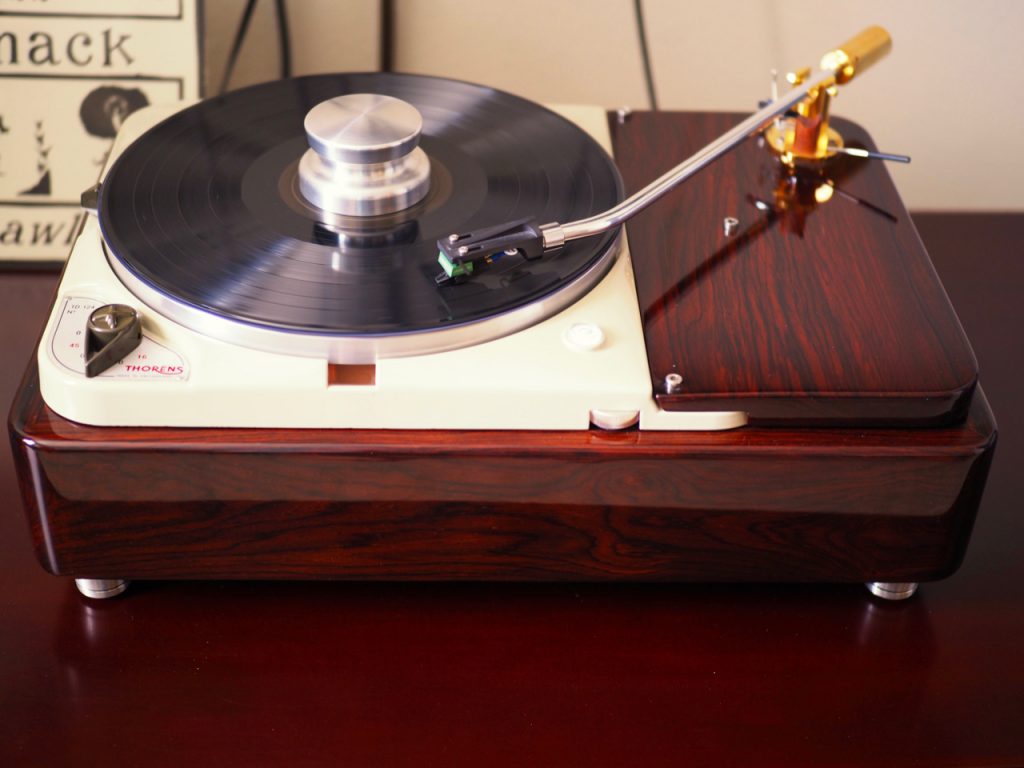
I followed Jaap’s and Chris’ advice and was rather astounded by the magnitude of performance improvement provided by these three simple additions, which had put my Thorens TD-124 on a level of performance similar to my hot-rodded Garrard 301, which you can read all about in the review HERE.
Jaap also suggested that a Hanze HiFi HAT Turntable Power Supply would improve the performance of my Thorens TD-124 even further, and asked me if I’d like to give one a listen and review it for Positive Feedback.
“Yes, indeed I would!” was my reply, so Jaap sent me a Hanze HiFi HAT Turntable Power Supply to listen to and review for Positive Feedback.
Outboard Turntable Power Supplies
Before I discuss the Hanze HiFi HAT Turntable Power Supply in detail, let me offer a basic primer on why you might want to consider using an outboard power supply for your turntable.
I think one of the best ways to explain how an outboard power supply can make a turntable sound better is to talk about how a turntable works to play back music from a vinyl record.
Hint: It's all about vibrations.
First of all, when you and your band go to the recording studio, you play your music in front of microphones, and microphones work much like your own ears in the way they respond to vibrations from music.
Your eardrum vibrates as it is struck by the musical waveforms, and those vibrations are converted to an electrical signal that is interpreted by your brain as music.
Similarly, when a microphone’s internal diaphragm is struck by musical waveforms it vibrates and turns those vibrations into an electrical signal, which are then encoded onto analog tape (or converted to digital media).
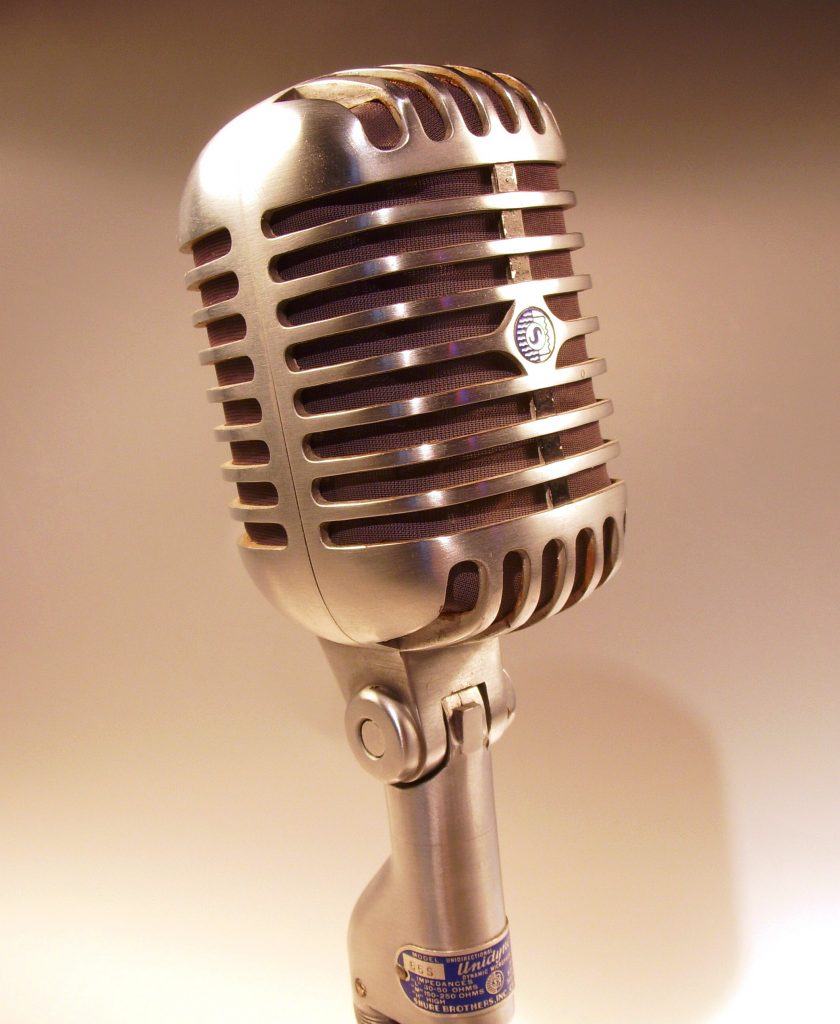
1951 Shure 55S microphone, photo courtesy of Wikipedia Creative Commons. Photo by Holger Ellgaard.
So, as the musicians play the music, the vibrations of the music are converted by microphones into an electrical signal that is stored on analog tape or digital media, then the electrical signal from the master is sent to a cutting lathe where the cutter head converts the electrical signal back into vibrations – or modulations – as it cuts a continuous groove into the lacquer. A “metal master” is made from the lacquer, a “mother” is then made from the metal master, a “stamper” is made from the mother, and then vinyl records are made using the stamper. I’ve simplified the process a lot, but hopefully you get the idea.
So now you’ve got your record in your hands, and you place your record on your turntable, and then lower the stylus, which is vibrated by the modulations in the record’s groove, and turns those vibrations back into an electrical signal that you hear as music coming from your hifi system. Again, I’ve simplified the playback process quite a lot, but you get the idea.
Ok, now you have the basics of making records and of record playback, which boils down to being all about turning the “good vibrations” of music into an electrical signal and then back again into music.
So, now back to our original question of why you might want to consider using an outboard power supply for your turntable – why would you want to do that?
The short answer is to reduce or eliminate the non-musical “bad vibrations” from the mains power supply and the turntable motor that degrades your turntable's cartridge's performance, as any fidelity lost at the source can’t be recovered down the line by your audio system electronics.
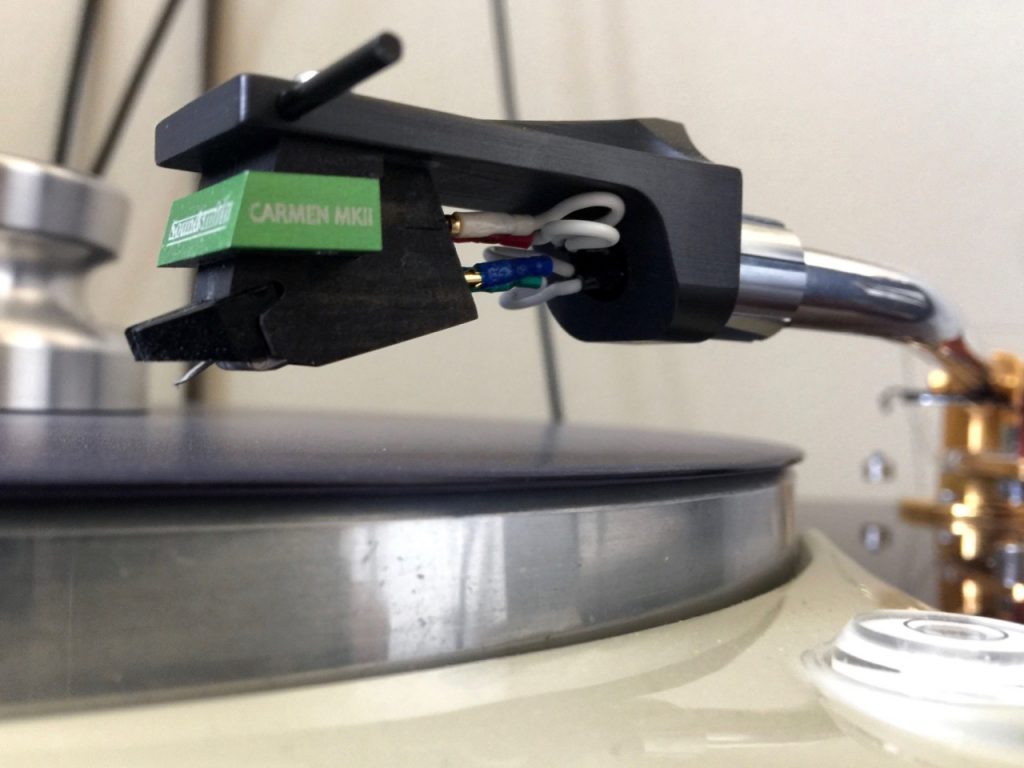
The phonograph cartridge picks up all vibrations, whether they are from the modulation in the record’s groove, or from footfalls or floor-borne vibrations, from the mains supply, or from the turntable motor itself.
All of these sources of non-musical vibrations degrade the signal-to-noise ratio of the music signal at the phonograph cartridge, lowering the fidelity of the music you hear from your hifi.
So, the moral of this story is that phonograph cartridges are very sensitive to vibration, and an outboard turntable power supply reduces vibrations that can be transmitted to the turntable's phonograph cartridge, thus improving the quality of the sound.
Most of you reading this article are familiar with the idea of placing a turntable on a vibration reducing stand or isolation footers (or both) to reduce vibrations from footfalls or other floor-borne vibrations, but other major sources of vibration - the mains voltage & turntable motor itself – can be addressed by the addition of an outboard power supply, which provides the turntable motor with a regenerated low-noise AC supply, and allows you to lower the line voltage going to the turntable motor, which lowers the amount of vibration from the motor, and results in an improvement to the sound quality due to better phonograph cartridge performance.
The Hanze HiFi HAT Turntable Power Supply
The Hanze HiFi HAT Turntable Power Supply is a substantial piece of finely crafted hifi electronics measuring 8¾ inches wide, by 5 inches high, and is 12 inches deep, and weighs in at approximately 11 pounds / 5 kilograms on my utility scale.
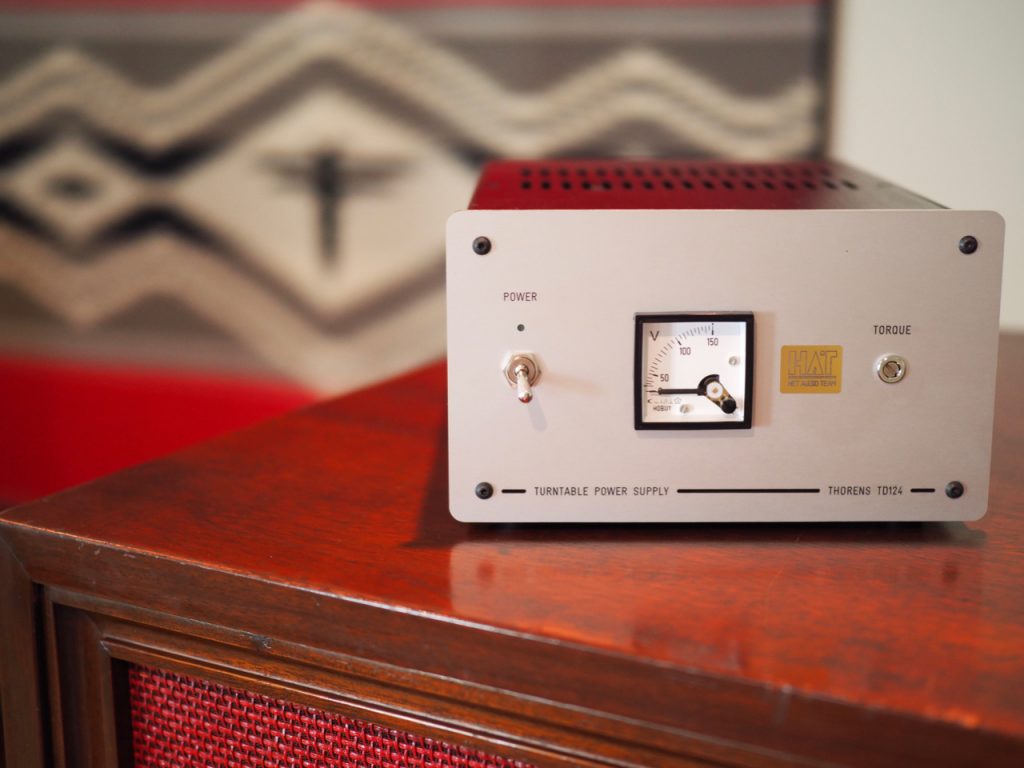
The casework for the HAT turntable power supply is sturdy aluminum plate, with the front panel approximately 4mm in thickness, the side panels slightly less than 4mm in thickness, and back, top, and bottom panels approximately 3mm in thickness, all held together by machine screws.

The HAT turntable power supply is built to a level of ruggedness and quality that many amplifiers would be jealous of.
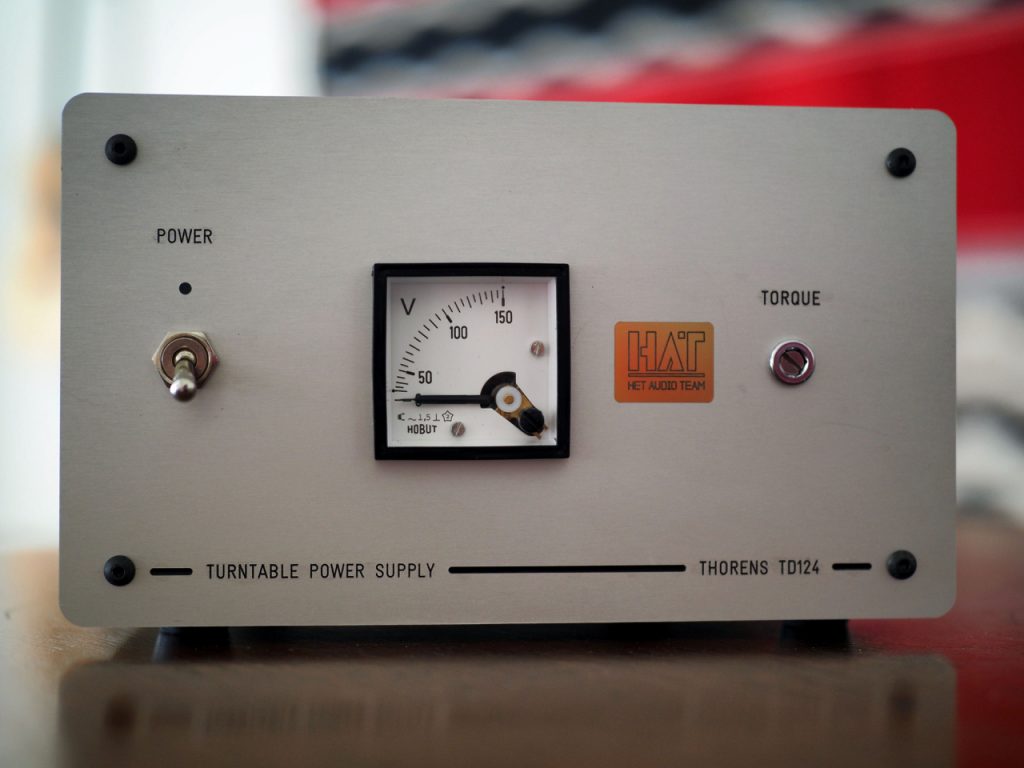
From left to right on the front panel (above) you see the power switch, voltage meter, and torque adjustment potentiometer.
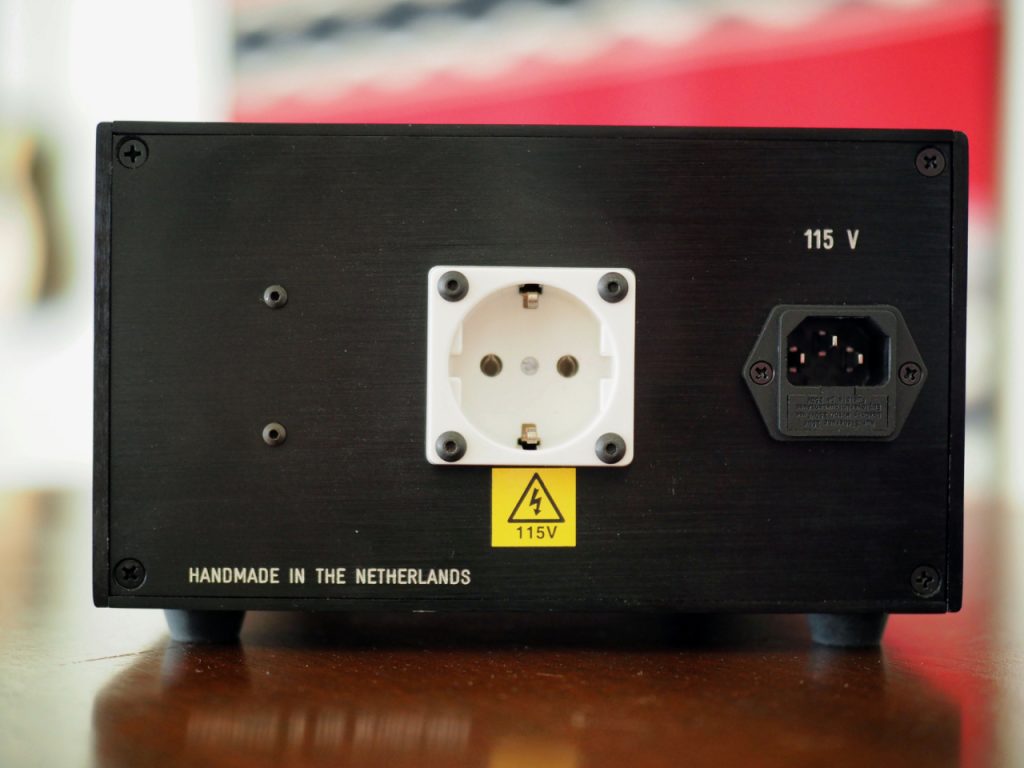
On the back panel you can see the center plug - a European-style Type F socket - that outputs AC to the turntable, and on the right side is a standard North American IEC male AC inlet plug for the wall AC.
In the particular unit sent for review, the central plug is a European-style Type F socket, as this is the first HAT Turntable Power Supply that was adapted for the 60 Hz / 120-volt North American power grid from the normal European version that Hanze HiFi offers, but future models shipped to North America will feature standard North American IEC male AC inlet plugs.
For this review I'll be using a plug-in adapter so I can use my turntable AC cable with a North American termination with the European-style Type F socket.
Now allow me tell you a little about how the Hanze HiFi HAT Turntable Power Supply came about.
Jaap told me, "Since all vibrations in record players start at the motor, I started looking for books explaining how the fractional motors work, as these are the kind of motors that were used in turntables. During this investigation it became clear to me that the motor in the turntable is primarily responsible for the speed and the vibrations."
"To be able to measure this, I went looking for a reference in the vibration measurement area and ended up with HP FFT signal analyzer and Bruel & Kjaer measuring equipment. Since industry has already made many measurements of standard electric motors, I also applied these techniques to the fractional motors in turntables."
"The vintage players mainly use three types of motors: the shaded-pole motor, the hysteresis-synchronous motor, and the capacitor induction motor. It is probably too much to explain the operation of each of these motors here, but in the Thorens TD124, the Garrard 301/401 (below), and the Lenco L75, the shaded-pole motors are used."

"What is important to know is that the speed is determined by the voltage, frequency and load offered."
"Previous research on standard motors has already shown that the quality of the mains voltage offered influences the degree of vibration and temperature of these motors, so we decided to do some research into this and to measure it, and more importantly determine how it affects the sound quality."
"Together with my friend Richard - together we form the Audio Team - we started to experiment with turntable power supplies for induction motors, as we already knew how much influence power supplies had on our tube amplifiers."
"The first results were really shocking, and we certainly did not expect this. A better power supply translated into blacker backgrounds, better low-level resolution, the grainy sound in voices was gone, and the soundstage was more stable and with better definition."
"The main reason for this I think is because the mains supply has been contaminated for many years, and there are many more frequencies present in it than just the 50 or 60 Hz, in the form of very strong harmonics."
"Measurements that I have done show that these can go up to 3KHz, and the voltage and frequency also varies. By offering a clean and stable newly generated voltage, the motor will vibrate less and the speed will be more constant."
"Do not forget that the turntable is dealing with vibrations that are transmitted through the chassis to the tonearm arm as well as via a belt - and the intermediate wheel - to the platter, and thus there is influence on the speed in the form of modulation in a kind of frequency wobble, called wow and flutter."
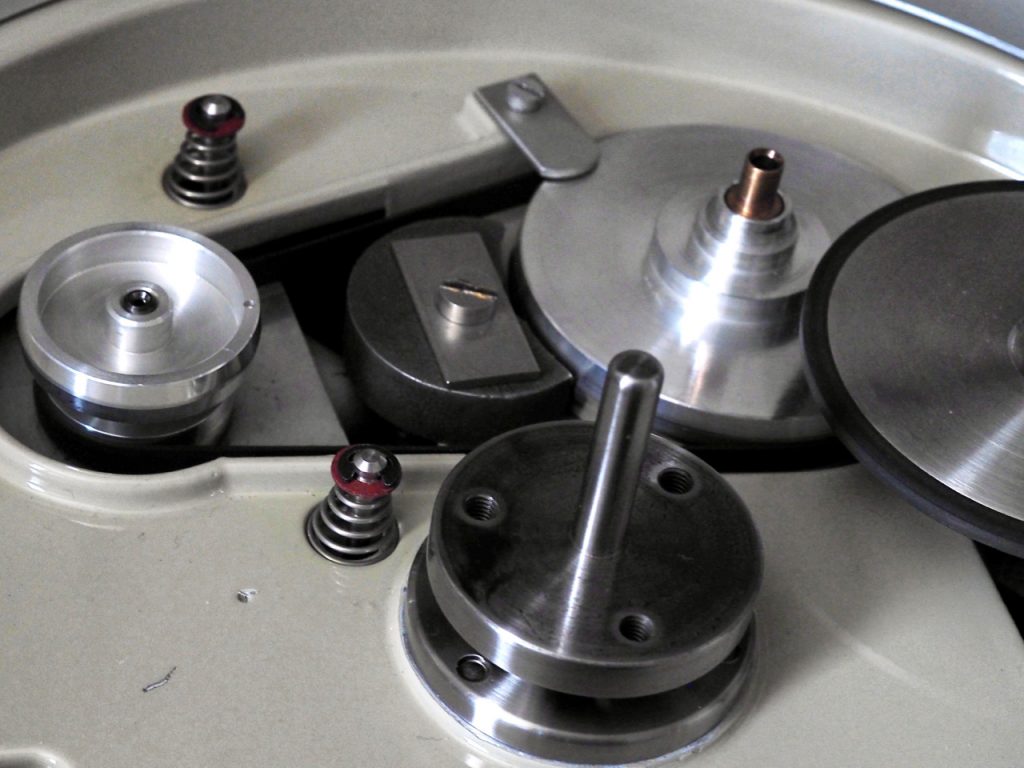
"The former can be suppressed by using optimal decoupling (above, note the springs on the motor mounts), but the latter is a lot more difficult. The motor is made up of a fixed part, the stator that takes care of the magnetic field, which causes the so-called rotor to rotate. This rotor is often directly coupled via the intermediate wheel to the platter or, as with the Thorens TD124, via a belt to the intermediate wheel."
"Here it is already determined how quiet and stable the record player will be and it is therefore logical to ensure that the motor is optimally controlled. In the optimum theoretical case we have to deal with two types of vibrations, the first of the rotating rotor speed between 23 and 30 Hz, depending on the mains frequency, and the voltage."
"The second most disturbing vibration is the so-called "two times the mains frequency vibration," 100Hz at 50Hz, or 120Hz at 60Hz. It's probably too much to go into the explanation here on how it arises, but it is always present with motors that are fed from a single-phase mains supply."
"However, not only a 50 or 60 Hz sine wave is offered, but also the derived harmonics that are very strongly present. These cause extra vibrations, and an unstable speed that is partly transferred by the rotor to the intermediate wheel or belt."
"There is some damping here for the vibrations, but not for the wow & flutter speed variations. The plateau partially compensates for this, but wow & flutter spectral measurements show that they are still present.
For speed control, the Thorens TD124 and Garrard 301/401 use an eddy current control that also introduces additional vibrations. The more it slows down, the more the vibrations."
"By setting the output voltage of the power supply a little lower, this control does not have to work as strongly and therefore produces fewer vibrations. However, an output voltage that is too low is at the expense of the torque, which does not benefit the sound."
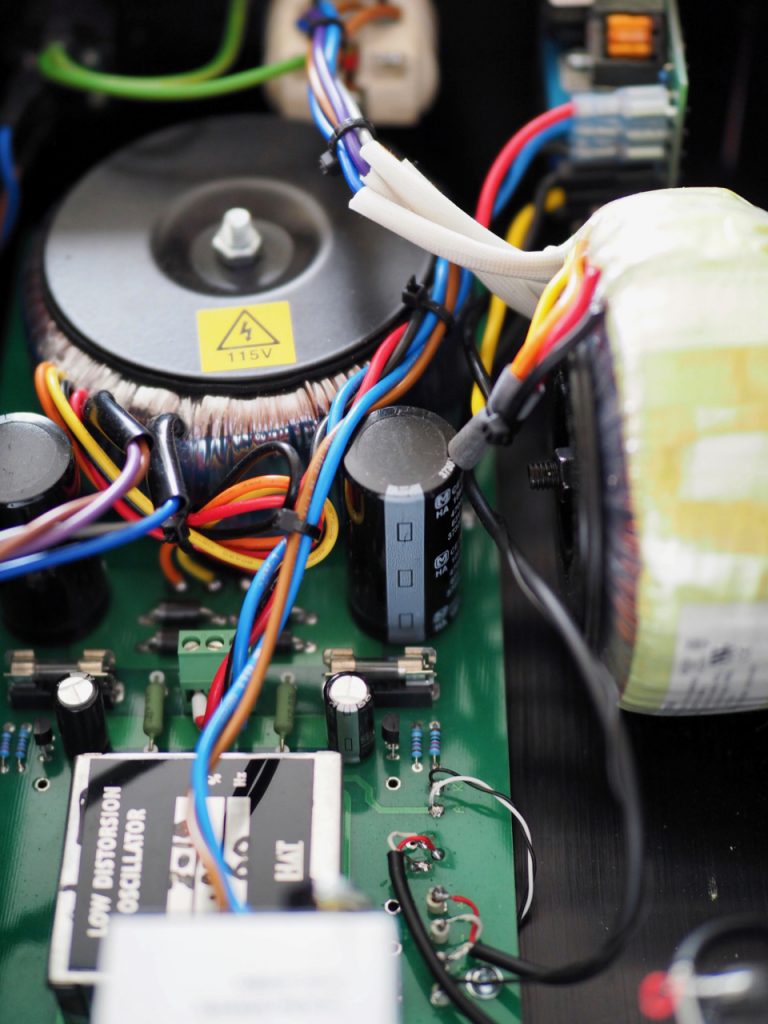
"All our turntable power supplies work with the same analog oscillator (above photo), variable or fixed to 50 or 60 Hz, this delivers a pure sine wave with a distortion of 0.02%, and the output voltage is adjustable with the so-called torque regulator to optimally adjust it for every turntable motor."
"Most vintage record player motors have a power consumption maximum of 20 VA, so our power supply is designed to be able to deliver this continuously without getting hot."
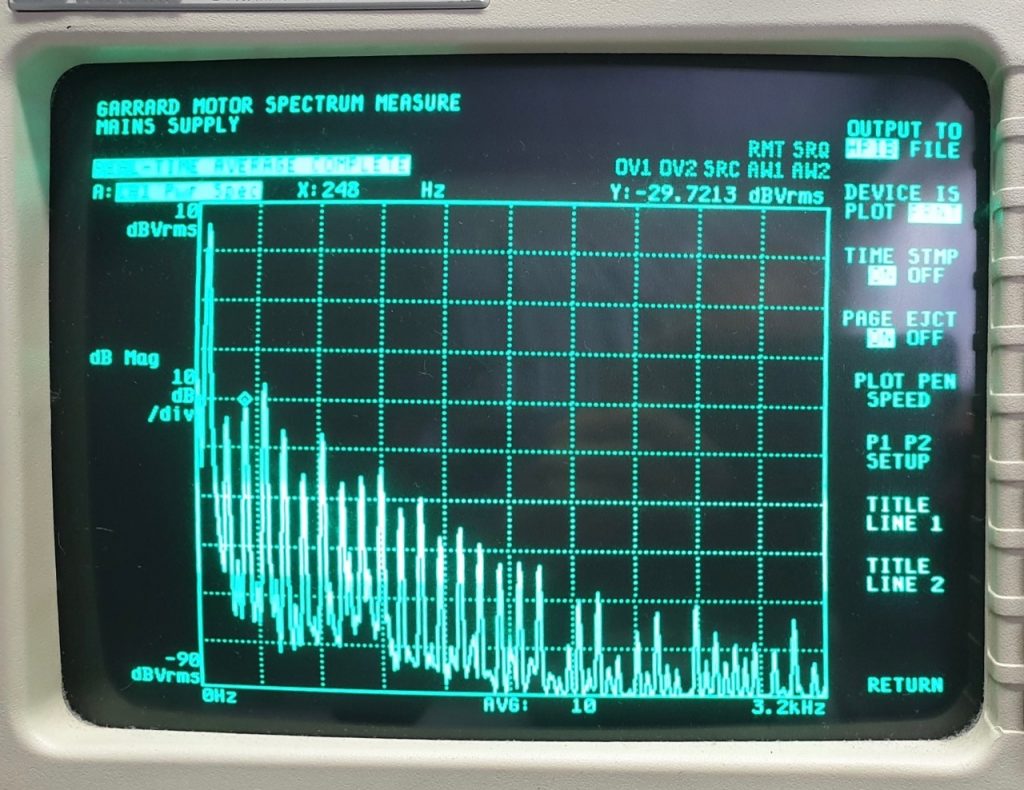
"The spectral current analyses show what is happening when the motor is connected to the mains supply (above). For a fair comparison, I have reduced the mains voltage to 200 volts by means of a Variac.”
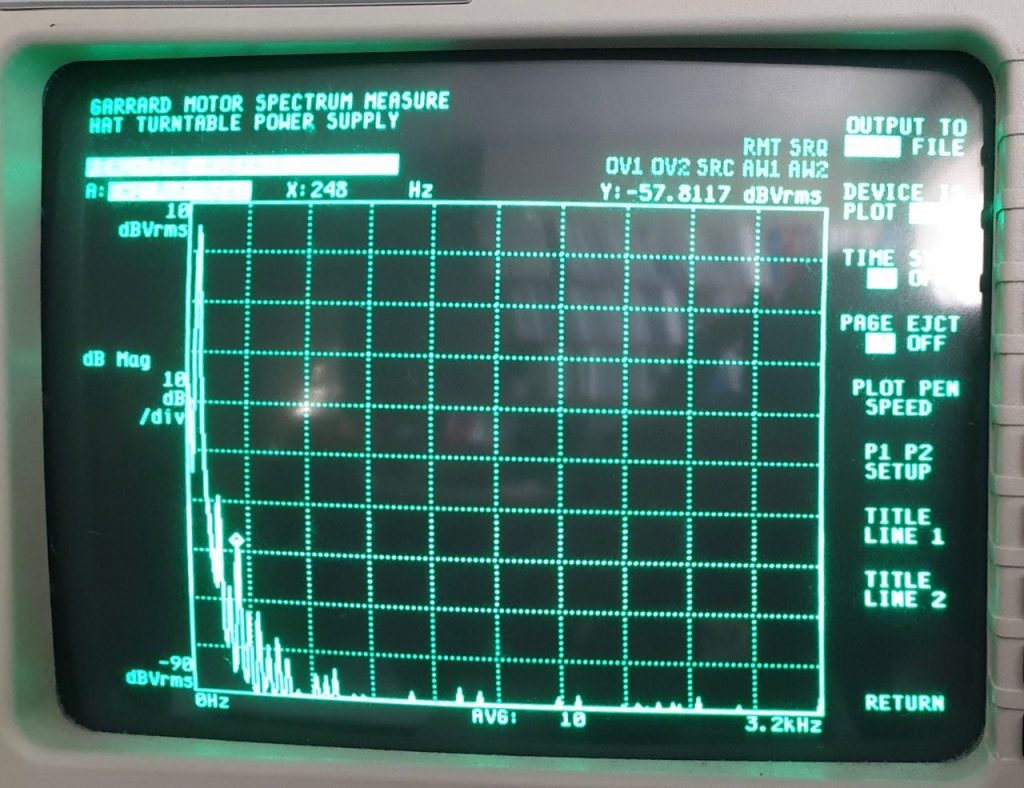
“The above spectrum is from the turntable connected to the HAT power supply at 200V, and you can see where the 5th harmonic goes from -37db to -81db!"
"Also, it can be seen that only lowering the mains supply to a lower voltage gave no better results, and harmonics stay, so passive filtering is no solution because 90% off the filters do not work at these low frequencies."
"Shaded pole motors are single-phase motors which must be controlled with a single-phase power supply. However, there are also record players that use single-phase motors because this is present, but can function much better with two phase or three phase motor control."
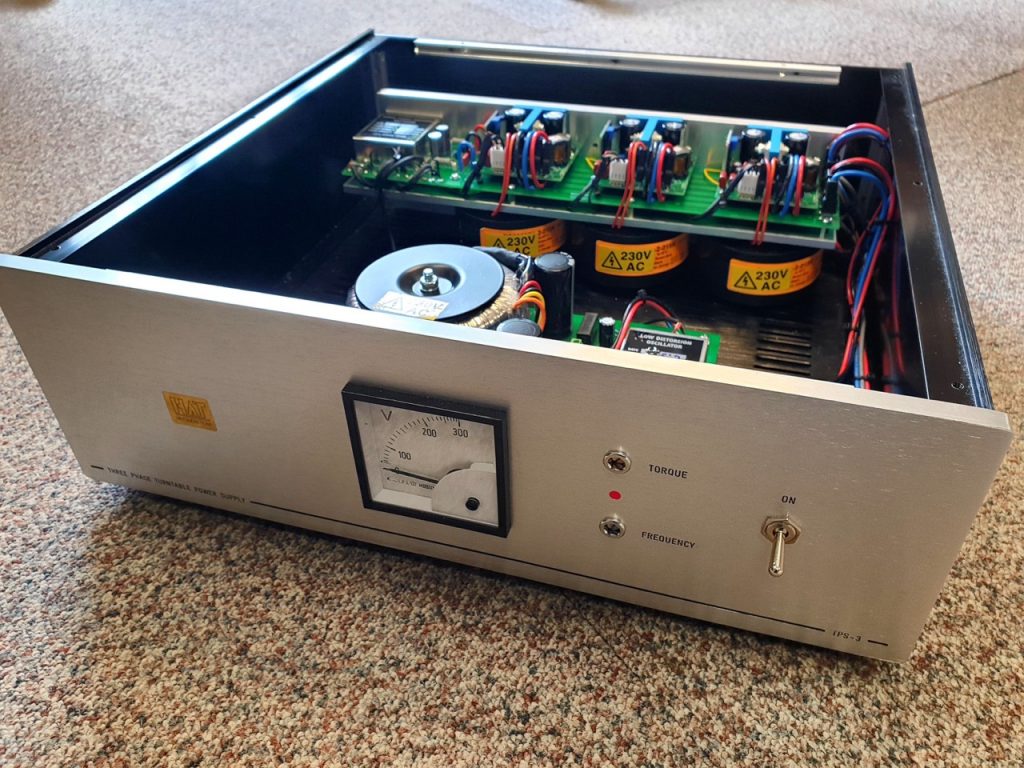
"Think of record players that use Bodine, Papst, Ashland and EMT motors, and for these we have developed special power supplies that are built to order (photo above), and with these power supplies it is possible to make these motors very good with respect to vibration."

Jaap says, "The power supply is built without compromise with the best components available."
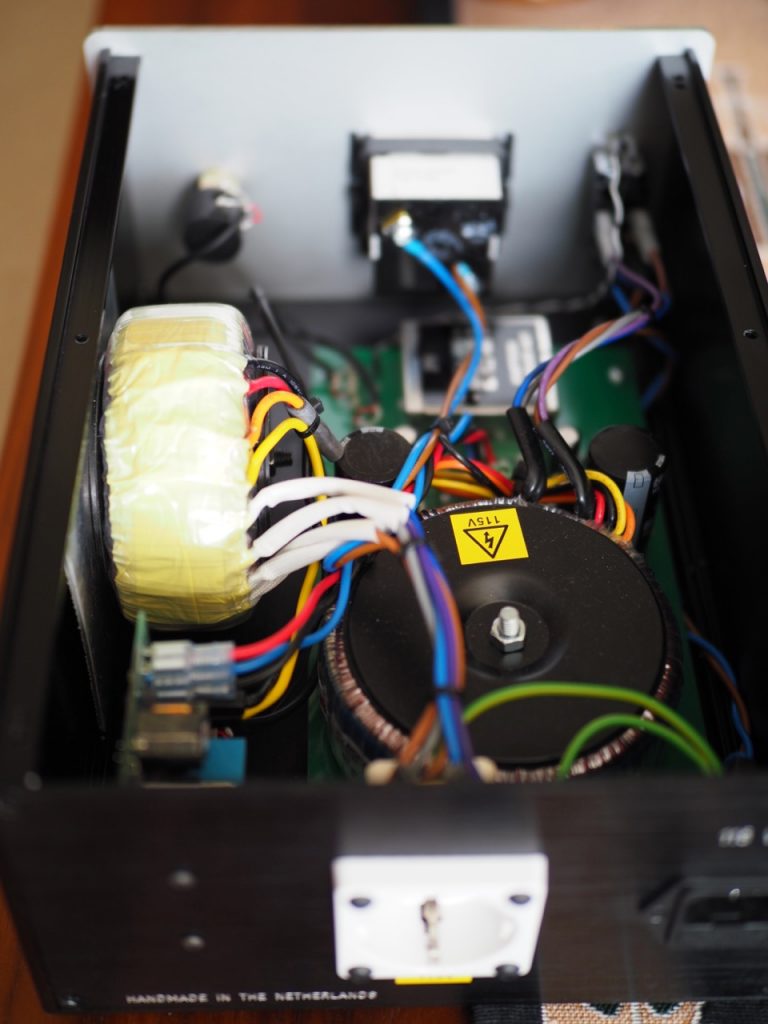
The Hanze HiFi HAT Turntable Power Supply’s circuitry is designed to deliver low-noise voltage to drive the turntable motor, and provides the owner the ability to run the motor at lower voltage to reduce vibration.
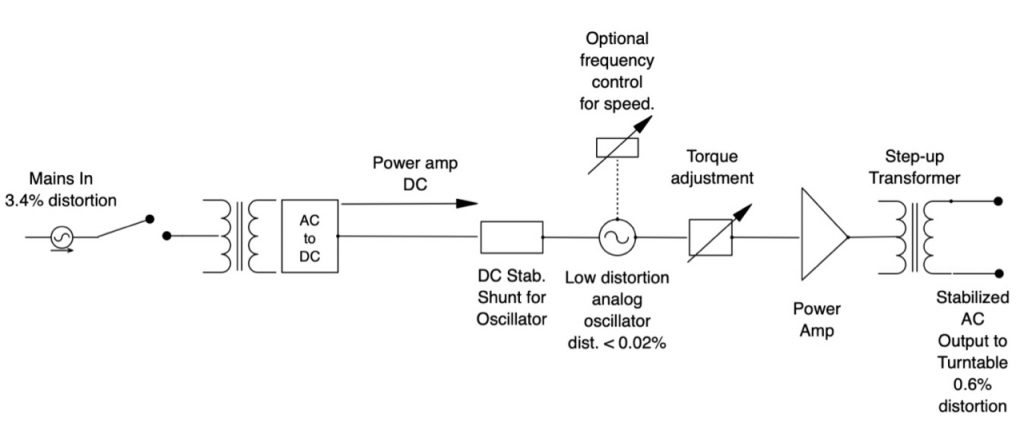
Diagram 1 - Note: the HAT TPS being reviewed does not have the optional frequency control for speed shown above.
Referring to the basic circuit diagram above for the HAT turntable power supply (above), I asked Hanze HiFi’s Jaap Pees if he would explain what the HAT turntable power supply does with the wall AC that comes into it, to give you a better idea of how it works to improve the performance of a turntable.
"The mains comes in by a two-pole switch to the primary side from the mains step-down transformer, where the secondary side (voltage AC) is connected to the rectifier stage/capacitor, which delivers the DC voltage for the power amp and the stabilizing voltage stage for the analog oscillator."
"This voltage stabilizer stage is very important as it needs to have a very low noise level and a good stabilization factor because it feeds the 60Hz analog oscillator, and the output from this analog oscillator is independent from the variations of mains supply!"
"The output voltage from the analog oscillator goes to the torque adjustment, and here the user can vary the output voltage for optimum drive (for achieving the lowest vibration possible in the turntable motor – Jeff), and after that the low voltage from the analog oscillator is amplified from about 2 volts to 115 volts."
"This occurs in two stages, first with the power amplifier which drives the secondary side of the power output step-up transformer, and secondly where the primary side of the step-up transformer drives the turntable motor."
"As you can see the turntable motor is totally isolated from the mains supply and runs on a newly generated sine wave with low distortion and a stable voltage/frequency."
"For example, the mains voltage here in the Netherlands has a gross distortion of about 3-4 % THD, while the voltage coming from the HAT turntable power supply has a clean sine wave output with about 0.6% THD."
I don’t know what the distortion is in the mains voltage where I’m located at in the USA, but my friend Ron Barbee is looking into the matter, so I might have more news soon.
I can tell you that in the USA and Canada national standards require that 60 Hz power be delivered at 120 volts ± 5% (114 volts to 126 volts), which means your mains voltage supply can vary in different locations, and also vary during the day due to different loads the grid experiences at different times of the day. The HAT turntable power supply’s regenerated AC essentially removes any mains voltage variation as being an issue the turntable motor has to deal with.
So, to sum up Jaap’s description of the HAT turntable power supply, it generates a new low-noise voltage source that is used to power the turntable’s motor, and it also allows the owner to reduce the voltage used to drive the turntable motor via the torque adjustment, which reduces vibration in the motor. The resulting cleaner power to drive the motor, and the ability to reduce vibration in the turntable motor via the torque adjustment, works together to improve the fidelity of the turntable’s performance.
You can see the HAT Turntable Power Supply on the Hanze HiFi website HERE. For the version of the HAT Turntable Power Supply with the torque control, the price is €1600, including 21% VAT, so for export outside the EU you would deduct the 21% VAT. By my calculation that means non-EU customers would pay €1185.
Review Systems
For this review I used two different systems, my main music listening system with my Classic Turntable Company / Artisan Fidelity Garrard 301 turntable, and my audio-visual system with my Artisan Fidelity Thorens TD-124 Statement turntable.
In both cases these turntables are some of the better examples of their kind, and are in better than new operating condition, with my Artisan Fidelity Thorens TD-124 Statement turntable having a newly restored motor (as well as everything else in it), and my Classic Turntable Company / Artisan Fidelity Garrard 301 turntable was serviced within the last 12 months, ensuring tip-top performance from both.
Main Music System Components
Since this review is about enhancing turntable performance, let’s start with a detailed description of the turntable in my main music system, the Classic Turntable Company / Artisan Fidelity Garrard 301 turntable.
If you read my The Garrard Project 2015: From Simple to Spectacular! article in Issue 79, you know the project team of Ray Clark (Classic Turntable Company), Christopher Thornton (Artisan Fidelity), and myself, went to great lengths to get maximum performance from the Garrard 301 turntable platform.
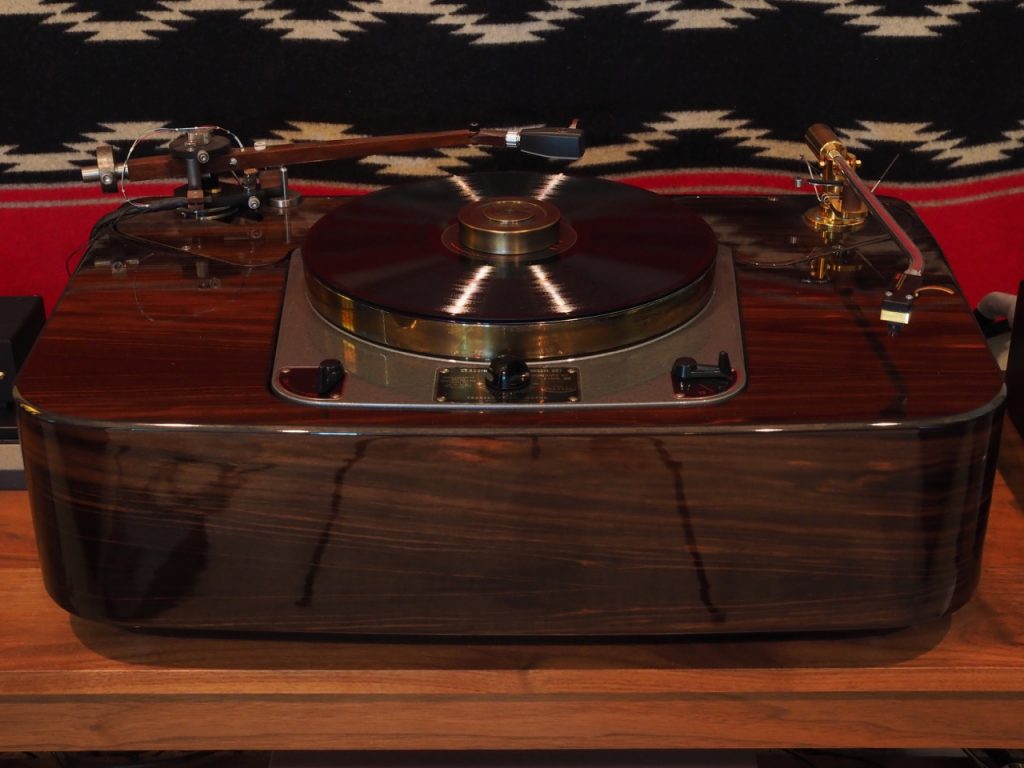
Ray Clark started with the basic Garrard 301 platform, but used a Garrard 401 motor instead of a 301 motor, as Garrard had replaced the aluminum motor housing of the 301 with a heavy cast iron housing in the 401 to help reduce vibration of the electric motor, and to provide magnetic screening, which improved the motor of the 401 to the point to where it was on par with most of the cutting lathes of the time in terms of rumble, wow, and flutter.
The flexy cast aluminum chassis of the original Garrard 301 was replaced with a rigid CNC’d aluminum chassis, and we used an oversized & perfectly balanced high-mass CNC’d brass platter, which spins on a precision spindle assembly uprated for the heavier platter.
The Artisan Fidelity “Statement” plinth is a constrained-layer damped high-mass design that was custom-fitted to Ray’s Classic Turntable Company Garrard 301, and allows for the use of two tonearms.
Christopher said the materials and design of the plinth were, "carefully chosen based upon tested and proven predetermined criteria which involves ideal resonant characteristics, material density and individual tonal attributes."
Christopher will not divulge the exact details of his plinth design (proprietary), but will say that "hand selected kiln dried domestic hard woods combined with premium Russian Birch plywood and a blend of ultra-premium synthetic sealer resins were chosen ultimately for their liveliness and superior overall tonal attributes. The use of an integral motor drain cavity has been implemented for proper dissipation of any unwanted excess motor vibrations."
The custom Artisan Fidelity “Statement” plinth was fitted with Stillpoints isolation feet to reduce floor borne vibration.
To further reduce vibrational effects from the motor and floor-borne vibration, I’ve added Soundcoat Company GPDS damping material between the Classic Turntable Company Garrard 301’s rigid CNC’d chassis and the Artisan Fidelity “Statement” plinth. The Soundcoat Company has been providing specialized noise control solutions for aerospace, medical, and industrial applications since 1963, and the strategic use of their various damping materials in audio components can make a big difference for reducing vibrational noise.
I use two tonearms on my Garrard 301 turntable, the first being a Thomas Schick 12-inch tonearm fitted with a Yamamoto HS-1A African black wood headshell, a Soundsmith Zephyr Mk III phonograph cartridge, and my DIY Art of Tone 22GA tinned-copper headshell leads.
Currently, the second tonearm is a 12.5-inch Pete Riggle Audio Engineering “Woody SPU” (review HERE) mounted with an Ortofon SPU Classic GM MkII stereo phono cartridge, stepped up with a bespoke Intact Audio SUT designed to get the best out of the Ortofon SPU Classic GM MkII.
For electronics, I used a Soundsmith MMP3 Mk II phono equalizer which I purchased following the review (HERE), and a SPEC RSA-M3 EX Real Sound Amplifier (review HERE).
For loudspeakers, I used custom Altec loudspeakers that were made for conductor and audio engineer Leopold Stokowski in the early 1960’s, which are fitted with state-of-art custom Duelund CAST tinned-copper crossovers that are part of the Duelund-Altec Project (the feature article about the Duelund-Altec Project will be coming this summer to Positive Feedback).
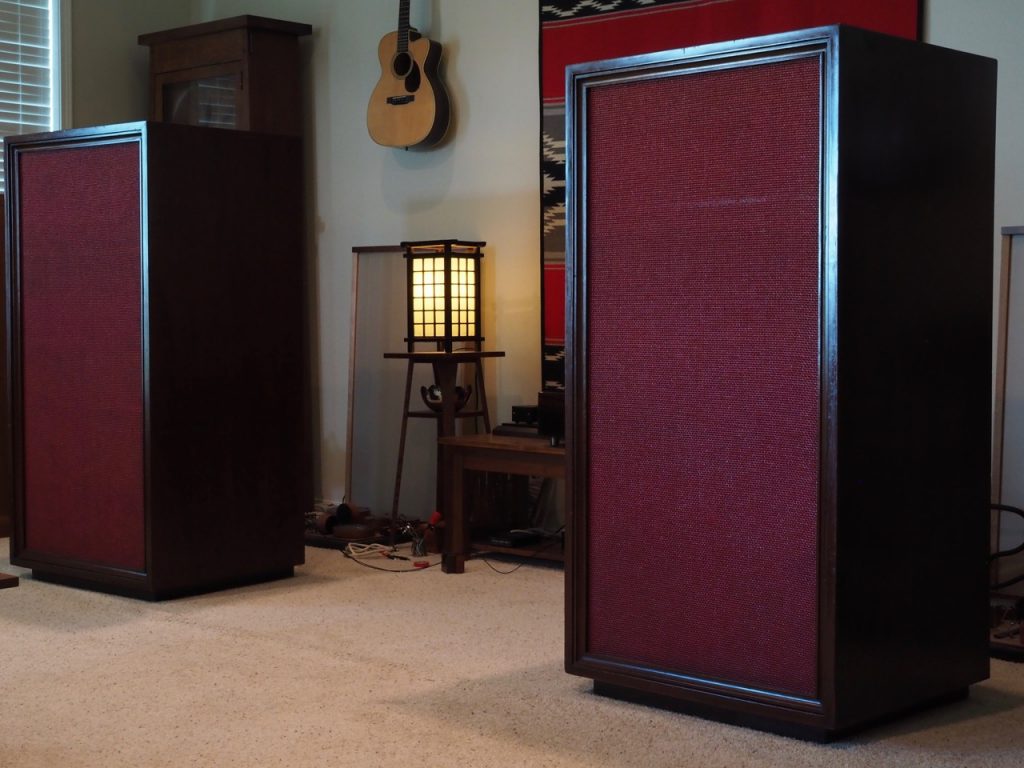
Duelund DCA20GA tinned-copper interconnects were used throughout, and Duelund DCA16GA tinned-copper wire was used as speaker cables (review HERE).
The mains AC power distribution starts at my AC wall outlet, consists of the Acoustic Revive CB-1DB receptacle base plate, the Acoustic Revive CFRP-1F carbon fiber outlet plate, and the Acoustic Revive modified Oyaide R-1 receptacle. The wall AC then leaves the outlet through an Acoustic Revive Absolute Power Cable (review HERE) and flows to an Acoustic Revive Absolute NCF Power Distributor (review HERE). From the Acoustic Revive Absolute NCF Power Distributor the AC is distributed to all of the components in my system via their AC power cords, which for this review was the Sablon Audio Petit Corona power cable that plugs into an Acoustic Revive RAS-14-TripleC NCF Power Stabilizer (review HERE), which is plugged into the turntable to power the motor.
Audio-Visual System Components
The audio part of my audio-visual system starts with my Artisan Fidelity Thorens TD-124 Statement turntable, which was restored and hot-rodded by Christopher Thornton of Artisan Fidelity, with all the deluxe sorts of things one expects from Christopher, like the "long base" plinth design that features a mass-loaded and constrained-layer damped Cocobolo and Panzerholz core, so I could accommodate my 12-inch Thomas Schick tonearm.
The custom Artisan Fidelity “Statement” plinth was fitted with Stillpoints isolation feet to reduce floor borne vibration.
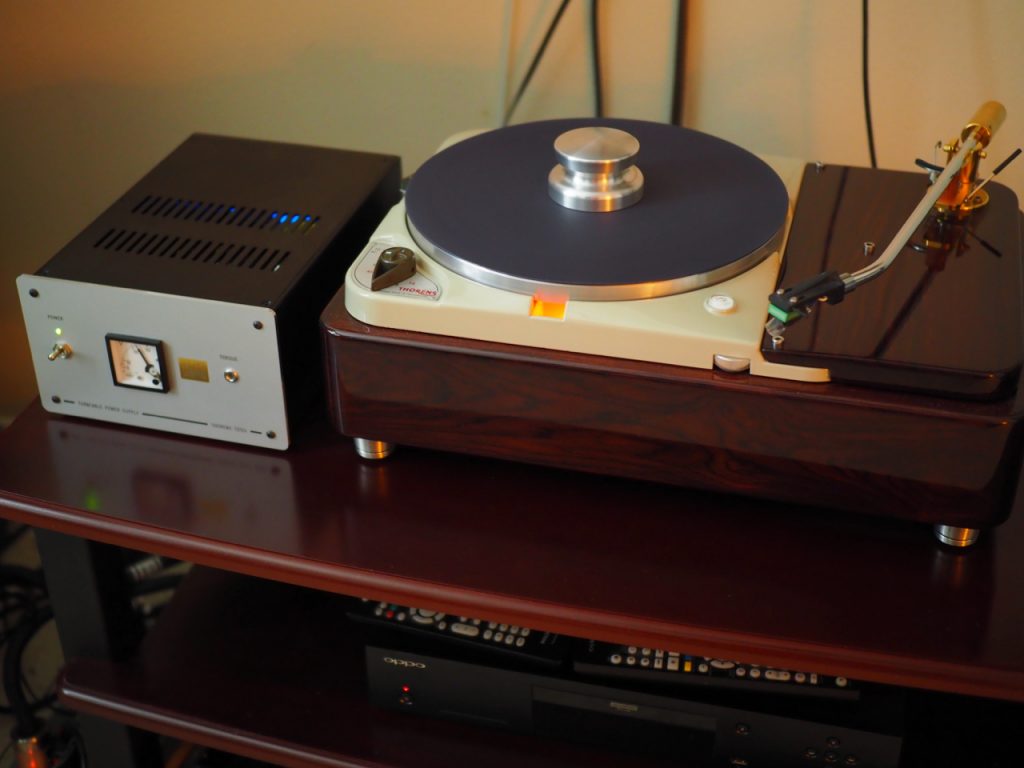
My Schick tonearm utilizes a Thomas Schick graphite headshell mounted with a Soundsmith Carmen MKII phonograph cartridge (review HERE), and is equipped with the exotic Acoustic Revive PC-TripleC/EX Headshell Leads (review HERE).
My Thorens TD-124 Statement is fitted "with a large bore stainless-steel self-lubricating precision main Sapphire bearing assembly featuring advanced synthetic co-polymer thrust pad," a CNC'd idler wheel with a stainless-steel hub, an austenitic stainless-steel precision balanced high mass main platter, and a Thorens factory restored TD124 aluminum clutch platter.
The TD-124 Statement has a new switch compressor condenser, a new Plexiglass strobe window, an E50 motor rebuild using new precision bushings, felt rings and seals, as well as a replacement stepped pulley wheel for the E50 motor.
Non-magnetic stainless-steel main chassis screws and armboard screws are used, and a Schurter IEC inlet with shielded oxygen free copper internal power cabling.
In my Artisan Fidelity Thorens TD-124 Statement turntable I also installed a Woodsong Audio Thorens TD-124 Platter Adapter ($75 USD), a SPEC AP-UD1 Analog Disc Sheet ($350 USD), an AudioSilente MKII suspension rods upgrade kit (€60 Euros, HERE), and a Hanze Hifi Thorens TD-124 Motor Decoupling Spring Kit (€39 Euros). You can read all about these Thorens TD-124 turntable upgrades in my Positive Feedback review HERE.
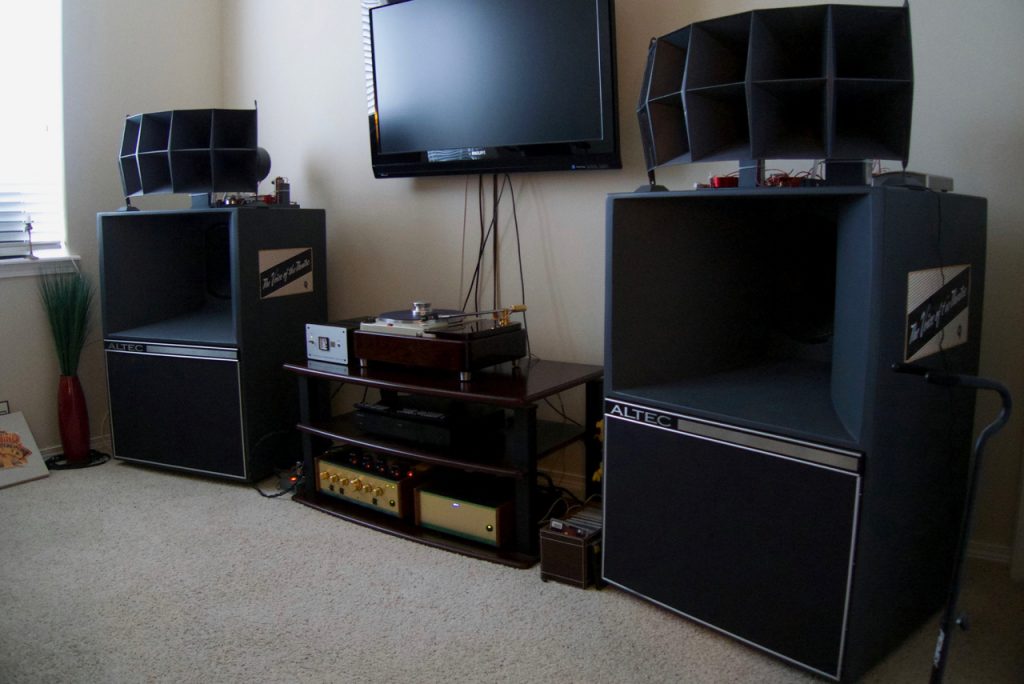
My vintage Altec A5 Voice of the Theatre loudspeakers were restored by Gary Fischer, which you can read more about HERE, HERE, and HERE.
The amplification electronics are long-time favorites of mine, the Leben CS-600 vacuum tube integrated amplifier and Leben RS-30EQ vacuum tube phono preamplifier, which makes for a great combination for providing thrilling music and film performances from the vintage Altec A5's.
I use Acoustic Revive RCA Absolute FM Interconnects for the Leben kit, an Acoustic Revive Absolute Power Cable for the CS-600, an Acoustic Revive Power Reference TripleC NCF AC Power Cable for the RS-30EQ, an Acoustic Revive RAS-14 AC Power Conditioner for the Thorens TD-124 (along with a Sablon Audio Petit Corona), and Duelund DCA16GA tinned-copper speaker cables to connect the Leben CS-600 to the Altec A5 loudspeakers. Everything is plugged into a Belkin ten outlet power strip, which in turn plugs into a generic AC outlet to connect to wall AC.
Listening Impressions
Ok, that's it for now. I hope you enjoyed the sneak peek into the Positive Feedback review of the Hanze HiFi HAT turntable power supply, and check back in a couple of days for the link to the full review at Positive Feedback.
As always, thanks for stopping by, and may the tone be with you!





























